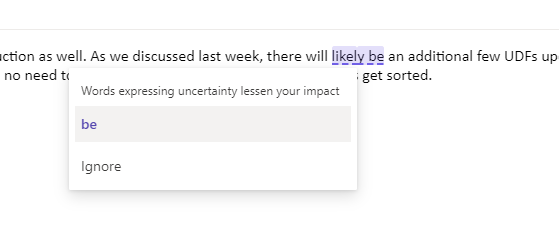I noticed an enhancement in the Outlook Web message composition today — in addition to a spell checker and auto-complete, there is grammar advice.
Month: September 2020
Dynamically determining AD Page Size
Question — is it possible to dynamically determine the maximum page size when communicating with AD via LDAP? Since the page size (1) changed between versions and (2) can be user-customized … a guess is sub-optimal.
Answer — yes. If only the default query policy is used, search at
CN=Default Query Policy,CN=Query-Policies,CN=Directory Service,CN=Windows NT,CN=Services,CN=Configuration,*domain naming context* (e.g.
CN=Default Query Policy,CN=Query-Policies,CN=Directory Service,CN=Windows NT,CN=Services,CN=Configuration,DC=example,DC=com) with a filter like “(&(cn=*))”
Return the ldapAdminLimits attribute. Parse MaxPageSize out of the attribute:
lDAPAdminLimits (13): MaxValRange=1500; MaxReceiveBuffer=10485760; MaxDatagramRecv=4096; MaxPoolThreads=4; MaxResultSetSize=262144; MaxTempTableSize=10000; MaxQueryDuration=120; **MaxPageSize=1000**; MaxNotificationPerConn=5; MaxActiveQueries=20; MaxConnIdleTime=900; InitRecvTimeout=120; MaxConnections=5000;
To find all of the query policies, search at CN=Query-Policies,CN=Directory Service,CN=Windows NT,CN=Services,CN=Configuration,*domain naming context* for (&(objectClass=queryPolicy)) … either research a lot about query policies and figure out how to determine which applies to your connection or take the lowest value and know you’re safe.
Minority Rule
Number of people represented by each rep in the Senate:
This is where I’d know small populations are over-represented. Two senators regardless of population — a state with a hundred residents would have two senators. Obviously we don’t have a state with a hundred residents — but the least populous states are the ‘best deal for residents’ list — lowest number of people represented by each Senator
| Size Rank | State | 2010 Population per Census | Senators | # Represented per Senator |
| 52 | Wyoming | 563,626 | 2 | 281,813.0 |
| 50 | Vermont | 625,741 | 2 | 312,870.5 |
| 49 | North Dakota | 672,591 | 2 | 336,295.5 |
| 48 | Alaska | 710,231 | 2 | 355,115.5 |
| 47 | South Dakota | 814,180 | 2 | 407,090.0 |
| 46 | Delaware | 897,934 | 2 | 448,967.0 |
| 45 | Montana | 989,415 | 2 | 494,707.5 |
| 44 | Rhode Island | 1,052,567 | 2 | 526,283.5 |
| 43 | New Hampshire | 1,316,470 | 2 | 658,235.0 |
| 42 | Maine | 1,328,361 | 2 | 664,180.5 |
And the most populous sates are the ‘worst deal for residents’ list — highest number of people represented by each Senator
| Size Rank | State | 2010 Population per Census | Senators | # Represented per Senator |
| 1 | California | 37,253,956 | 2 | 18,626,978.0 |
| 2 | Texas | 25,145,561 | 2 | 12,572,780.5 |
| 3 | New York | 19,378,102 | 2 | 9,689,051.0 |
| 4 | Florida | 18,801,310 | 2 | 9,400,655.0 |
| 5 | Illinois | 12,830,632 | 2 | 6,415,316.0 |
| 6 | Pennsylvania | 12,702,379 | 2 | 6,351,189.5 |
| 7 | Ohio | 11,536,504 | 2 | 5,768,252.0 |
| 8 | Michigan | 9,883,640 | 2 | 4,941,820.0 |
| 9 | Georgia | 9,687,653 | 2 | 4,843,826.5 |
| 10 | North Carolina | 9,535,483 | 2 | 4,767,741.5 |
Number of people represented by each rep in the House of Representatives:
But the apportionment in the House of Representatives isn’t as equitable as one might assume. It’s a different list of states under- and over- represented … but one rep from Rhode Island represents half a million people. One rep from Montana represents just short of a million people!
Best deal for residents — small number of people represented by each rep
| Size Rank | State | 2010 Population per Census | Reps | # Represented per Rep |
| 44 | Rhode Island | 1,052,567 | 2 | 526,283.5 |
| 52 | Wyoming | 563,626 | 1 | 563,626.0 |
| 39 | Nebraska | 1,826,341 | 3 | 608,780.3 |
| 38 | West Virginia | 1,852,994 | 3 | 617,664.7 |
| 50 | Vermont | 625,741 | 1 | 625,741.0 |
| 43 | New Hampshire | 1,316,470 | 2 | 658,235.0 |
| 24 | South Carolina | 4,625,364 | 7 | 660,766.3 |
| 21 | Minnesota | 5,303,925 | 8 | 662,990.6 |
| 42 | Maine | 1,328,361 | 2 | 664,180.5 |
| 13 | Washington | 6,724,540 | 10 | 672,454.0 |
Worst deal for residents — high number of people represented by each rep:
| Size Rank | State | 2010 Population per Census | Reps | # Represented per Rep |
| 45 | Montana | 989,415 | 1 | 989,415.00 |
| 46 | Delaware | 897,934 | 1 | 897,934.00 |
| 47 | South Dakota | 814,180 | 1 | 814,180.00 |
| 40 | Idaho | 1,567,582 | 2 | 783,791.00 |
| 27 | Oregon | 3,831,074 | 5 | 766,214.80 |
| 31 | Iowa | 3,046,355 | 4 | 761,588.75 |
| 25 | Louisiana | 4,533,372 | 6 | 755,562.00 |
| 28 | Oklahoma | 3,751,351 | 5 | 750,270.20 |
| 18 | Missouri | 5,988,927 | 8 | 748,615.88 |
| 32 | Mississippi | 2,967,297 | 4 | 741,824.25 |
Electoral College:
The combination of which yields the over and under representation in the Electoral College (and the reason I think the National Popular Vote Interstate Compact is such a good idea).
Best deal:
| Size Rank | State | 2010 Population per Census | Electoral Delegates | # Represented per Delegate |
| 52 | Wyoming | 563,626 | 3 | 187,875 |
| 51 | District of Columbia | 601,723 | 3 | 200,574 |
| 50 | Vermont | 625,741 | 3 | 208,580 |
| 49 | North Dakota | 672,591 | 3 | 224,197 |
| 48 | Alaska | 710,231 | 3 | 236,744 |
| 44 | Rhode Island | 1,052,567 | 4 | 263,142 |
| 47 | South Dakota | 814,180 | 3 | 271,393 |
| 46 | Delaware | 897,934 | 3 | 299,311 |
| 43 | New Hampshire | 1,316,470 | 4 | 329,118 |
| 45 | Montana | 989,415 | 3 | 329,805 |
And the worst deal
| Size Rank | State | 2010 Population per Census | Electoral Delegates | # Represented per Delegate |
| 1 | California | 37,253,956 | 55 | 677,345 |
| 3 | New York | 19,378,102 | 29 | 668,210 |
| 2 | Texas | 25,145,561 | 38 | 661,725 |
| 4 | Florida | 18,801,310 | 29 | 648,321 |
| 5 | Illinois | 12,830,632 | 20 | 641,532 |
| 7 | Ohio | 11,536,504 | 18 | 640,917 |
| 10 | North Carolina | 9,535,483 | 15 | 635,699 |
| 6 | Pennsylvania | 12,702,379 | 20 | 635,119 |
| 11 | New Jersey | 8,791,894 | 14 | 627,992 |
| 8 | Michigan | 9,883,640 | 16 | 617,728 |
Divide by Zero Error
None of which speak to the almost five million people who are unrepresented in the Legislature. Or the just short of one million people who aren’t even represented in the Electoral College.
| Size Rank | State | 2010 Population per Census | Reps | # Represented per Rep | Senators | # Represented per Senator | Electoral Delegates | # Represented per Delegate |
| 29 | Puerto Rico | 3,725,789 | 0 | #DIV/0! | 0 | #DIV/0! | 0 | #DIV/0! |
| 51 | District of Columbia | 601,723 | 0 | #DIV/0! | 0 | #DIV/0! | 3 | 200,574 |
| 53 | Guam | 159,358 | 0 | #DIV/0! | 0 | #DIV/0! | 0 | #DIV/0! |
| 54 | U.S. Virgin Islands | 106,405 | 0 | #DIV/0! | 0 | #DIV/0! | 0 | #DIV/0! |
| 56 | Northern Mariana Islands | 53,883 | 0 | #DIV/0! | 0 | #DIV/0! | 0 | #DIV/0! |
| 55 | American Samoa | 55,519 | 0 | #DIV/0! | 0 | #DIV/0! | 0 | #DIV/0! |
And the spreadsheet, in case it’s useful to someone else.
Protected: Images from along our property
Mushrooms
On Rioting
They grow up so fast
Anya keeps telling me that chickens grow up so fast … which is both true and so funny coming from the Anya who also seems to grow up really fast. The little balls of fluff are half feathers now, and getting bigger (and more chicken-like) every day. We had our first escape yesterday. I’d clipped a mesh over the top of the brooder when they first started fluttering. But one of the dark-feathered birds was roosting on top of the chicken toaster and pushed her way out of the cover. Now we’ve got more clips, and it seems to be secure.
And they love going outside to play. We’ve had a few really busy days and haven’t been able to take them out. Tomorrow looks a little cool, but the weekend and the first few days next week look like perfect chicken playing weather.
Chalk Tightrope Race
Anya’s online school includes physical education — they provide ideas for games we can play, and we we tweak the idea. Last week, they wanted us to stand on one foot and play catch with a ball. That turned into a cross between volleyball and tennis. The activity this week was to draw a few chalk figures (circle, triangle, line, zig-zag) and pretend those are a tightrope. Anya turned it into a race — you start by running along the long line, leaping to the triangle, following it and then leaping to the circle, running along the circle, jumping to the next circle and running along it, then leaping over to a short line that gets you to the zig-zag. There was a lot of running into each other (especially when she added the “go either direction around the shape” rule), and it was really hard to win if you didn’t want to run over the tiny person. Which makes it one of Anya’s favorite games.
Not a golf shot, but …
I should know better than to apply logical thought to Trump’s blathering, but … the scenario of a golfer choking is that they miss an easy shot under pressure, right? Like the ball is three foot away from the hole, the golfer has a putter in hand, a reasonable stance, and the club is aimed to hit the ball in the general direction of the hole. Aaaand then they hit it a little hard, or a little soft, or have a little spin that throws off the shot. The Kenosha cop? In golf terms, that’s trying the three foot shot with a 9mm instead of the putter.



